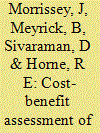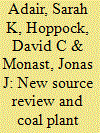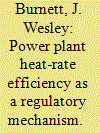|
|
|
Sort Order |
|
|
|
Items / Page
|
|
|
|
|
|
|
| Srl | Item |
| 1 |
ID:
118831


|
|
|
|
|
| Publication |
2013.
|
| Summary/Abstract |
This article focuses on the impact of the discount rate on cost-benefit assessment of investment options for residential building efficiency. An integrated thermal modeling, life cycle costing approach is applied to an extensive sample of dominant house designs for Australian conditions. The relative significance of predicted thermal performance and the applied discount rate on the Present Value of energy savings from alternative investment scenarios is investigated. Costs and benefits are also evaluated at the economy-wide scale, including carbon pricing considerations, and for a test-case household faced with alternative investment options at the point of construction. The influence of the applied discount rate on produced cost-benefit calculations is investigated, as is the interaction between critical cost-benefit input parameters. Findings support that the discounting framework is the primary driver of difference in estimates about costs and benefits of higher standards of efficiency in the residential sector. Results demonstrate that agreement on a low discount rate based on sustainability principals would prioritise those projects with significant environmental benefits.
|
|
|
|
|
|
|
|
|
|
|
|
|
|
|
|
| 2 |
ID:
166379


|
|
|
|
|
| Summary/Abstract |
To facilitate energy system transition, China needs to further optimize energy structure and improve energy efficiency. Compared with physical energy consumption, effective energy consumption can better reflect the actual household energy consumption level. Based on a review of relevant literatures and official statistics, we first estimated the amounts of biogas, dung and solar energy utilized by rural households, and set up the time series of actual rural household energy consumption. The effective energy consumption was measured by the thermal efficiency of fuels from existing literatures, and main characteristics and trend of energy structure change were revealed. Finally, possible scenarios of energy use in 2030 were analyzed. The results show that per capita physical energy consumption and effective energy consumption reached 546.4 kgce and 142.5 kgce in 2015, respectively. The multiple thermal efficiency of all fuel increased from 16.02% in 1990 to 26.08% in 2015, to which the main contributor was energy structure change rather than physical energy consumption growth. The trends including total energy consumption declining and per capita energy consumption growing will continue until 2030. The shares of clean and efficient non-solid fuels in total energy consumption will further increase, whereas the share of renewable energy will decline.
|
|
|
|
|
|
|
|
|
|
|
|
|
|
|
|
| 3 |
ID:
132769


|
|
|
|
|
| Publication |
2014.
|
| Summary/Abstract |
Forthcoming carbon dioxide (CO2) regulations for existing power plants in the United States have heightened interest in thermal efficiency gains for coal-fired power plants. Plant modifications to improve thermal efficiency can trigger New Source Review (NSR), a Clean Air Act requirement to adopt of state-of-the-art pollution controls. This article explores whether existing coal plants would likely face additional pollution control requirements if they undertake modifications that trigger NSR. Despite emissions controls that are or will be installed under the Mercury and Air Toxics Standards (MATS) and Clean Air Interstate Rule (CAIR) or its replacement, 80% of coal units (76% of capacity) that are expected to remain in operation are not projected to meet the minimum NSR requirements for at least one pollutant: nitrogen oxides or sulfur dioxide. This is an important consideration for the U.S. Environmental Protection Agency and state policymakers as they determine the extent to which CO2 regulation will rely on unit-by-unit thermal efficiency gains versus potential flexible compliance strategies such as averaging, trading, energy efficiency, and renewable energy. NSR would likely delay and add cost to thermal efficiency projects at a majority of coal units, including projects undertaken to comply with forthcoming CO2 regulation.
|
|
|
|
|
|
|
|
|
|
|
|
|
|
|
|
| 4 |
ID:
169744


|
|
|
|
|
| Summary/Abstract |
In August 2018, the U.S. Environmental Protection Agency (EPA) proposed a new policy – the Affordable Clean Energy rule – to reduce greenhouse gas (GHG) emissions from existing coal-fired electric generating units and power plants. The new rule establishes emissions guidelines, including heat-rate efficiency improvements, for states when developing plans to limit GHG emissions. Past studies have indicated that heat-rate efficiency improvements can increase electricity output, leading to a reduction in emissions rates and an increase in emissions levels – a rebound effect that can temper the emissions-reduction benefits of plant-level heat-rate efficiency. This study adds to the literature by examining data on the relationship of plant-level heat-rate efficiency on the rate and level of GHG emissions. We explored three different types of GHGs – carbon dioxide, methane, and nitrous oxide. Controlling for variation across operators, our results suggest that gains in heat-rate efficiency are associated with higher levels of all three pollutants. Specifically, we found that a ten percent increase in heat-rate efficiency led to an average seven-to-nine percent increase in the level of GHG emissions. Our analysis highlights the need to further study the full effects of heat-rate efficiency policies before such rules are enacted.
|
|
|
|
|
|
|
|
|
|
|
|
|
|
|
|
| 5 |
ID:
150454


|
|
|
|
|
| Summary/Abstract |
The utilization of agricultural biomass for production of electric power can help to reduce the environmental emissions while achieving energy security and sustainable development. This paper presents a methodology for estimating the power production potential of agricultural biomass in a country. Further, the methodology has been applied to develop a roadmap for producing reliable power in India. The present study reveals that about 650 Mt/year of agricultural biomass is generated in India, while about one-third of this has been found to be surplus for energy applications. The cereal crops have major contribution (64.60%) in production of surplus biomass followed by sugarcane (24.60%) and cotton (10.68%). The energy potential of these resources is of the order of 3.72 EJ, which represents a significant proportion of the primary energy consumption in the country. These biomass resources can produce electric power of 23–35 GW depending upon the efficiency of thermal conversion. The delivery of biomass to the plants and selection of appropriate technology have been found as the major issues that need to be resolved carefully. In the end, the study summarizes various technological options for biomass collection and utilization that can be used for producing clean and consistent power supply.
|
|
|
|
|
|
|
|
|
|
|
|
|
|
|
|
| 6 |
ID:
136249


|
|
|
|
|
| Summary/Abstract |
Under its recently proposed Clean Power Plan, the U.S. Environmental Protection Agency (EPA) gives states several “building blocks” to choose from to reduce their power plants’ CO2 emissions, including improving plants’ heat rate efficiency. However, skeptics suggest that precisely because efficiency enhances electrical output, it may reduce power plants’ emission rates but increase their emission levels. Using the EPA’s new Greenhouse Gas Reporting Program (GHGRP) data, this paper conducts the first analysis of the effect of thermal efficiency on the rate and level at which individual power plants emit carbon dioxide. Consistent with the arguments of skeptics, we find that while efficiency lowers CO2 emission rates, it actually increases CO2 emission levels. In suggesting to states that improving efficiency is one of the best systems of emission reductions, therefore, the EPA needs to consider whether more efficient plants are subject to such “rebound effects.”
|
|
|
|
|
|
|
|
|
|
|
|
|
|
|
|
|
|
|
|
|